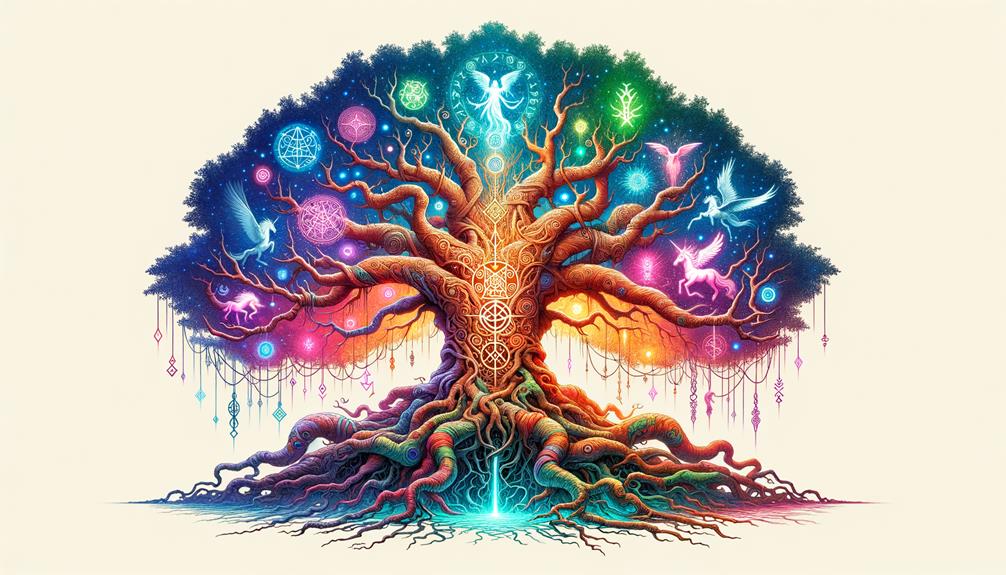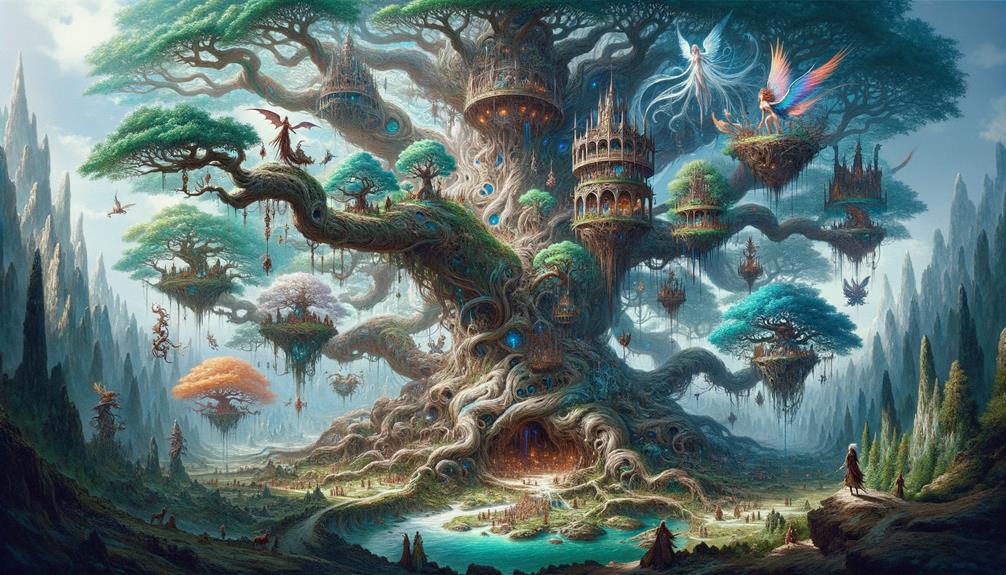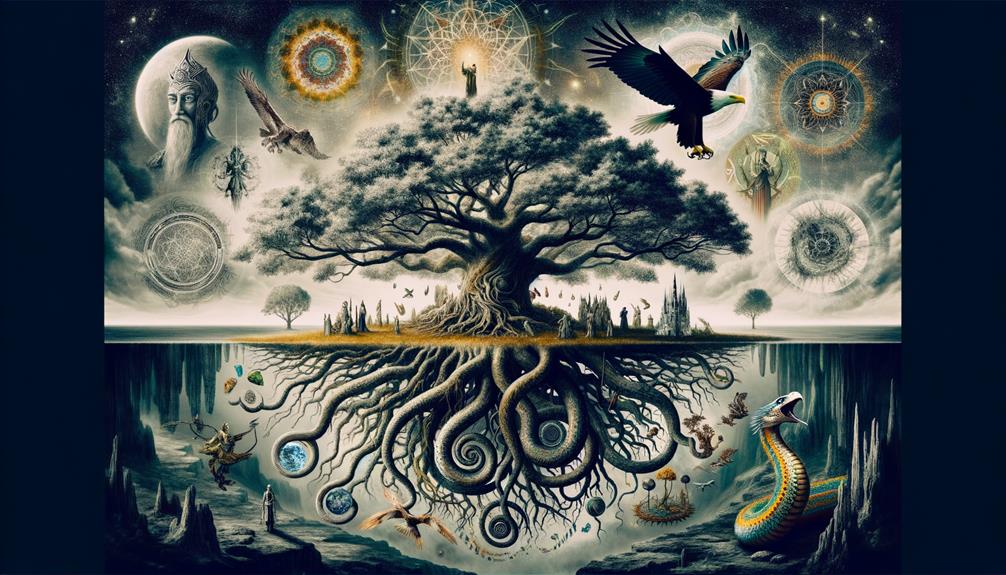Have you ever heard of Yggdrasil, the colossal ash tree from old Norse mythology that holds the entire universe? If you're a fan of mythology like me, you'd be intrigued by the complex story of this fascinating tree. Its roots dig deep into wells filled with knowledge, wisdom, and fate. Its branches stretch out, connecting the nine dimensions of existence. Yggdrasil symbolizes many things ranging from personal to universal concepts. It represents sacrifice, rebirth, and the intricate link between all things. As we journey through its extensive branches and into the depth of its roots, we meet gods, creatures, and spirits that live in this cosmic tree. We also ponder deep questions about existence, destiny, and the unity of all things. Now you might be wondering, why does this tree from an old belief system still pique our interest today? Let's find out together.
Origins of Yggdrasil

Yggdrasil, a giant ash tree, is a significant symbol in Norse mythology. The tree is part of the 124 known entities in Norse paganism, indicating the pivotal role trees played in ancient Germanic cultures. Yggdrasil's stature and reach are so impressive that the divine beings use it as their gathering place.
The tree's three roots stretch out to different parts of the universe, adding to its symbolic importance. In the Norse perspective, Yggdrasil's branches cover the Nine Worlds, creating a complete cosmic layout of the universe. Each of the Nine Worlds has its unique inhabitants and landscapes, all linked together by Yggdrasil, promoting unity and continuity.
Many different creatures inhabit Yggdrasil, such as Níðhöggr, an eagle, and the stags Dáinn, Dvalinn, Duneyrr, and Duraþrór. These creatures all contribute to the tree's vibrant ecosystem, reflecting the complexity and diversity of life in the cosmos. As for the name Yggdrasil, it comes from Old Norse. 'Ygg' is one of Odin's names, and 'drasill' means horse. This name symbolizes Odin's self-sacrifice and his connection with the tree.
Structure and Symbolism

Let's take a closer look at Yggdrasil, a significant element of Norse cosmology, and try to understand its structure and symbolism. Yggdrasil, a giant tree detailed in the Prose Edda, a 13th-century work by Snorri Sturluson, holds a sacred spot in Norse mythology.
As we decode the symbolism of Yggdrasil, we find it's a treasure chest of meanings:
- The structure: Yggdrasil stands on three roots, each reaching out to a different world. This represents how everything in the universe is interconnected.
- The majestic Yggdrasil spreads its branches high in the sky, a symbol of divine connection and spiritual evolution.
- Various creatures live on the world tree, each one playing a unique part in the Norse cosmological narrative.
As for the symbolism, Yggdrasil is more than just a physical entity:
- Yggdrasil stands for stability and continuity and is seen as the world's central axis.
- The three roots of this tree are seen as symbols of the past, present, and future, thus representing time's passage.
This tree, with its intricate structure and profound symbolism, gives us a captivating insight into the complex Norse viewpoint.
Inhabitants of Yggdrasil

In the sprawling limbs and roots of the revered Norse tree, Yggdrasil, a diverse array of beings have made their home. These beings each hold a special place in the stories and myths surrounding this sacred tree. They call Yggdrasil home, enriching its tales and symbolizing various facets of life and the cosmos.
Perched on the highest branch of the world tree, we find a mysterious eagle, whose keen eye represents wisdom and might. There's also a squirrel, known as Ratatoskr. This little critter has a unique job – he carries messages between the eagle high above and the dragon Níðhöggr far below. This dragon, lurking in the depths of Yggdrasil's roots, embodies destructive powers. The ongoing exchange of messages between these two paints a picture of the eternal battle between creation and destruction, a key concept in Norse mythology.
But it's not just animals you'll find in Yggdrasil. Three goddesses known as the Norns are also part of this lively community. They take care of the well Urðarbrunnr and weave the threads of destiny, shaping the lives of gods and mortals alike. So, you see, the inhabitants of Yggdrasil reflect a broad range of cosmic forces and influences. Each one adds a unique thread to the rich tapestry that is Norse mythology.
Yggdrasil in Norse Mythology

We've spent some time discussing the various creatures that call Yggdrasil home, so now let's shift our attention to the outsized part this hallowed tree holds in Norse myth. Yggdrasil, also known as the world tree, acts as the epicenter of Norse cosmology. It's like a giant, cosmic network, with its roots and branches extending into the nine worlds, creating a critical connection among these diverse areas.
As an Ash tree, Yggdrasil embodies life and the interconnectedness of everything. This is evident in:
- The name 'Yggdrasil' itself, a combination of 'Ygg', one of Odin's names, and 'drasill' meaning horse. This link to Odin, the Allfather, gives the tree an air of divine power and wisdom.
- The beings that live within and around it: an eagle, the stags Dáinn, Dvalinn, Duneyrr, and Duraþrór, and the world serpent Níðhöggr gnawing at its roots. These denizens symbolize different facets of life, death, and renewal.
- The role of the tree as the axis mundi, or the tree of life, bringing order and balance across the cosmos.
Yggdrasil, reaching deep with its roots and high with its branches, is a powerful embodiment of the Norse perception of the universe, showing the complex balance and interplay of life.
Yggdrasil's Modern Interpretations

Yggdrasil, an iconic tree from the Norse mythology, continues to inspire countless modern-day interpretations. We see it expressed in various forms of art, literature, and academic studies. The tree's central role in the cosmic order of the Nordic world is often highlighted in these interpretations, symbolizing interconnectedness, stability, and growth.
Here are a few examples:
- Artwork: Numerous sculptures and drawings depict Yggdrasil as an enormous tree, reaching towards the sky.
- Literature: In the Japanese light novel series 'Overlord', Yggdrasil is represented as a majestic tree at the core of the world.
- Scholarly works: Academic discussions often focus on Yggdrasil's role as the axis mundi in Norse belief.
The tree Yggdrasil is revered as a sacred symbol, its roots spread far into the celestial domains. It stands as one of the most recognized sacred trees, cementing its importance in mythology. The endurance of Yggdrasil, the world tree, is evident in modern interpretations. This captures the tree's essence and highlights its ongoing relevance when delving into the spiritual and mystical aspects of life.
Frequently Asked Questions
What Is the Short Story of Yggdrasil?
In the Norse spiritual belief system, the revered World Tree, Yggdrasil, serves as a bridge linking nine different worlds. Its branches and roots are inhabited by a variety of beings, like an eagle, a dragon, and four deer. This iconic tree represents the concepts of connection, growth, and constancy in the context of Norse mythological traditions.
What Does the World Tree Symbolize?
So, what I've learned from my research is that the World Tree stands for the complex web of life and the universe, as well as the cycle of life. It's like a steady rock we can lean on, representing the wisdom of the gods. Plus, it's a kind of junction that connects different layers of existence.
Who Is at the Bottom of Yggdrasil?
So, who's hanging out at the base of Yggdrasil, you ask? Well, it's none other than Níðhöggr, a pretty intense dragon. This guy spends his time munching on the tree's roots, which represents the destructive elements in the world. But don't get it twisted, even though he seems scary, he's actually part of this universal cycle of creation and destruction. It's all a part of the natural ebb and flow of life!
Who Destroyed Yggdrasil?
Have you ever wondered who was responsible for the destruction of Yggdrasil? Well, if we go by the tales of Norse mythology, it was the catastrophic event known as Ragnarök that brought about the end of this immense ash tree. Picture a scene of extreme chaos, with raging fires and devastating floods, all symbolizing the end of an era and the dawn of a new one. Now that's a story that grabs your attention, doesn't it?

